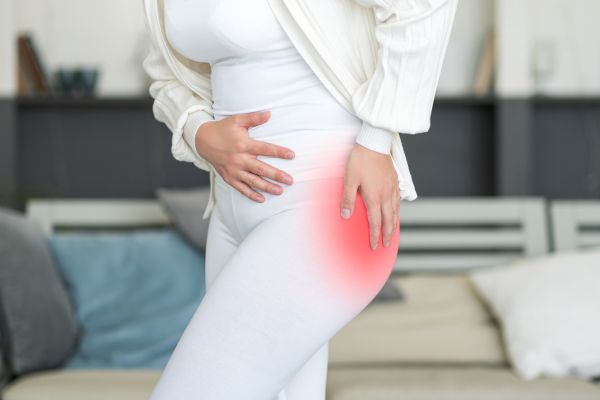
The hip is one of the body’s largest and most stable joints. Intended for a wider range of motion, this ball-and-socket-style joint bears a significant amount of weight. It’s also surrounded by various ligaments, tendons and soft tissues for support.
An injury to this area can affect your mobility on a broader scale and often requires physical therapy for recovery. Learn about the most common hip injuries.
About the Hip Joint
The thighbone or femur fits into an indent within the pelvis, which has three sections: the ilium, which flares outward, the pubis or inner portion and the ischium, which defines hip shape. In addition to bones, muscles, tendons and ligaments, fluid-filled sacs called bursae keep the joint lubricated.
Causes of Hip Injuries
The amount of weight the hip supports can cause this joint to develop arthritis before other body parts. The hip area is also vulnerable to trauma, including from falls, accidents or playing sports and may experience a fracture or dislocation injury.
Intensive participation in sports or another rigorous activity can also place stress on this area and contribute to a repetitive strain injury.
People are more likely to develop a hip injury if they:
- Are over 60 years old
- Engage in activities that place excessive pressure on the hip area, including skiing, running, hockey, soccer or gymnastics
- Have developed osteoporosis
- Carry around excess weight
- Have balance problems
- Work in a job requiring regular standing and walking
- Lead a sedentary lifestyle
- Have a vitamin D deficiency
Common Hip Injuries
Hip injuries affect the bones and various soft tissues in this area:
- Contusions: Sports injuries can lead to hip contusions. Severity can range from a superficial bruise to deeper damage accompanied by swelling, pain and injury to the ilium. This hip injury typically heals on its own with RICE and taking an over-the-counter pain reliever.
- Osteitis Pubis: The pubic symphysis becomes inflamed from repetitive use. Athletes who routinely use the hip joint to make large motions have higher injury risks and may need to take time off or undergo steroid injections during recovery.
- Hip Arthritis: The cartilage supporting your hip joints shows signs of wear after age 60. For patients with osteoarthritis, the surrounding tissue starts to break down due to inflammation, leading to stiffness, pain, swelling and weakness in the area.
- Bursitis: This condition develops from repetitive motion placing strain on the bursae sacs. They become inflamed and their cushioning effects decrease, causing pain whenever the joint moves. Beyond overuse, hip bursitis may occur in response to a spinal condition or rheumatoid arthritis.
- Snapping Hip: This sports condition involves one or more soft tissues. The iliotibial band or hip flexors may snap or the cartilage or labrum surrounding the hip socket can tear.
- Femoroacetablar Impingement: The growth of a bone spur along the ball-and-socket joint may damage surrounding tissues, contribute to chronic pain and affect mobility.
- Dislocation: Sudden force applied to the hip bone can push the thighbone out of its socket. Dislocation may occur in a backward direction (posterior) or forward (anterior) and damage muscles, ligaments, soft tissues, the labrum and nerves in the process.
- Hip Fractures and Breaks: These fractures generally involve the upper portion of the femur and may occur due to trauma, osteoporosis or a progressive sports injury and worsen with nutritional deficiencies. Surgery may be required to fully heal the injury.
- Hip Strains: These occur in response to pulling or tearing a ligament in this area and frequently stem from intensive athletic activities like football, wrestling and boxing. Pain, weakness, spasms, swelling and bruising can signal a strain.
- Labral Tear: The sheet of cartilage that passes through the socket to support the joint can experience a tear, which not only causes pain but affects the joint’s stability and may contribute to dislocation.
- Hip Instability: This may occur in response to various pelvic injuries and is characterized by unsteadiness and inconsistent mobility. Athletic injuries, congenital disabilities, repetitive motion, falls and accidents may also contribute to hip instability.
- Hip Dysplasia: A loose connection in the ball-and-socket joint increases the risk of dislocation. While you tend to be born with this condition, damaged soft tissue may accelerate its development.
- Subluxation: This trauma-induced injury pushes the ball out of the joint and may occur in response to sports, a fall or a car accident. Treatment involves resetting the joint.
How to Prevent Hip Injuries
To reduce your risks for developing a hip injury:
- Exercise regularly, specifically focusing on balance
- Ensure you get enough vitamin D and calcium
- Lose weight to place less stress on your joints
- Avoid over-training for sports and activities involving the hips
- Practice RICE – rest, ice, compression and elevation – when you notice pain and seek medical attention as soon as possible.
Work with the physical therapists at Integrated Rehab as you recover from a hip injury. To learn more about our services, contact us today.

